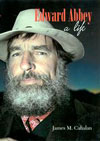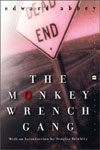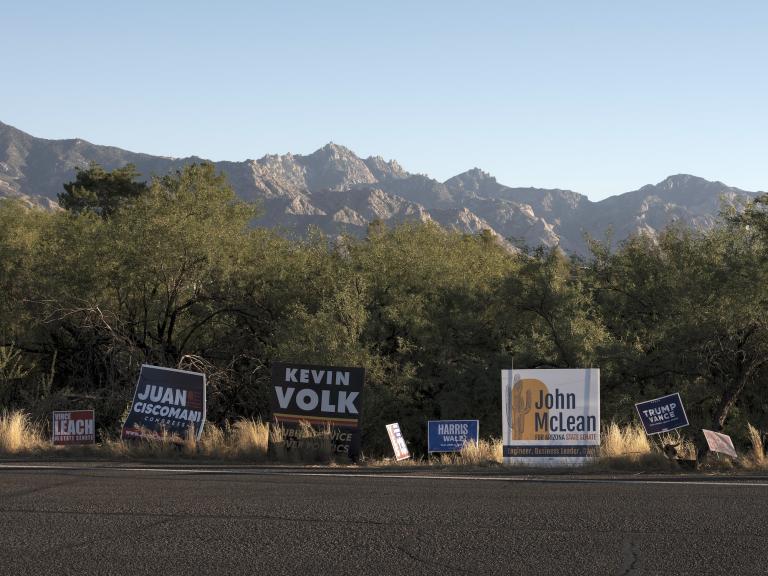Writing a biography of an author can be a challenging task — how much do you write about the subject’s life, how much about the work? — and reviewing such a biography even more so. That is especially the case when the subject of the biography is Edward Abbey, who wanted to be a novelist but wrote himself into several identities, among them wilderness Jeremiah and curmudgeonly cowboy. Abbey regularly complained that reviewers wrote too much about him and not enough about his books, a criticism that could be aptly applied to James Cahalan’s new biography, Edward Abbey: A Life.

Edward Abbey: A Life
By James Cahalan
University of Arizona
Press, 366 pages, 2002
Abbey remains best known for Desert Solitaire and The Monkey Wrench Gang, works born of a fiery passion to see America kept wild, even if only in places. He frequently joked that his duty was to “the West: Keep it like it was.” This pointed confusion of tenses was appropriate for a man who was often — and pointedly — confused. Cahalan’s book is quite effective, if not quite thrilling, at (meticulously!) describing the various threads of that confusion and attempting to unify them into a single, clear narrative. Its chief concerns are to separate the reality from the fiction of Abbey’s life — to demythologize him — and to ennoble his writing with academic and critical appreciation.
At these goals he succeeds quite well, but that success may be of dubious value. I say so because Abbey’s finest writing, whether essay or novel, is so suffused with his personality that any effort to demystify it may only kill what is best in it. Still, some of Cahalan’s main themes deserve to be addressed. One is the recurring question of whether Abbey was a misogynist. Cahalan quotes Abbey’s last wife Clark — the one to whom he was actually faithful, and perhaps the one who forced him to grow up — as complaining that Abbey treated women “as sexual objects in his books” but then going on to say, “He didn’t treat me that way. He didn’t treat the women he knew in that way.” The author’s father, Paul Abbey, refused to read past the first chapter of The Fool’s Progress because he was so troubled by the narrator’s lechery.
Writing in his journals, Abbey himself remarked of the same narrator that “Lightcap is an arrogant, swaggering, macho, obnoxious and eccentric character — but he learns some humility in the end. Good for him.” Barbara Kingsolver and Terry Tempest Williams, among others, found Abbey to be a kind, gracious fellow who gave sound editorial advice and was nothing but supportive. Perhaps the best explanation of Abbey’s attitudes towards women comes, by analogy, from his defense of his anti-immigration stance: “I’d like to be a good liberal … but the temptation to defy old American taboos often gets the best of me.” Maybe the gulf between intellectual feminism and a sense of erotic entitlement was similarly insurmountable.

Which brings us to anarchism. In life (for example, his master’s thesis in philosophy arguing that violence against people had never been sufficiently justified) and even in death (witness his illegal burial in the desert), Abbey beat the anti-authoritarian drum. Indeed, this position is so central to Abbey’s makeup that Cahalan is forced to repeat it over and over again. At a time when our government has declared the Earth Liberation Front to be one of America’s leading domestic terrorist organizations based solely on the value of the property it has damaged, Abbey’s position merits pondering. Cahalan, apparently a guilty lover of brash boyishness, clearly admires his subject’s eco-terrorist persona, but fails to adequately investigate whether that persona justified Abbey’s politics, or the other way around. You might just as well read The Monkey Wrench Gang, get some gasoline and burn some billboards, if you want to understand this aspect of Abbey better than Cahalan is able to explain it.
Overall, I was left ambivalent about the utility of Cahalan’s biography. Being palatable to academics might have caused Abbey to vomit beer across his feet — or maybe not. This was a man, after all, who tossed beer cans onto the road because, he claimed, it was the road, not the beer cans, that was ugly. The book is dryly written, profusely footnoted, and obsessed with separating fact from fiction in Abbey’s life and stories. He was not born in Home, nor ever lived in Oracle, for instance. But as these relatively trivial corrections to the record suggest, the book fails to add very much to a reading of Abbey’s own words. Its chief merit may lie in reminding people that his books are still around. If you like the dependability of journalism, skip Abbey and read this biography. If, however, like Abbey himself, you appreciate the need for tall tales, lies, and embellishments — not to mention obliterating passion and powerful wrath — just read him.


